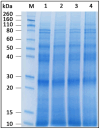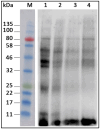Ultrasound and Heat Treatment and Its Potential to Reduce Fennel Allergenicity
- PMID: 40647003
- PMCID: PMC12248577
- DOI: 10.3390/foods14132251
Ultrasound and Heat Treatment and Its Potential to Reduce Fennel Allergenicity
Abstract
Fennel (Foeniculum vulgare), a member of the Apiaceae family, is known for its culinary and medicinal uses, as well as its potential to cause allergic reactions. Thermal and nonthermal technologies are commonly applied during the production of fruit and vegetable-based products, which may contain allergenic proteins. Consequently, understanding how these processing treatments affect allergenicity is crucial for managing allergenic risks during manufacturing and for identifying technologies that can reduce the allergenic potential of the final products. Currently, there is limited information available on how thermal and ultrasonic processing methods affect the allergenic properties of fennel. The aim of this study was to investigate the effects of ultrasound and heat treatment on the in vitro immunoreactivity of protein extracts from fennel. After sonication and heat treatment, the protein extracts were analyzed by denaturing polyacrylamide gel electrophoresis, Western blot and enzyme-linked immunosorbent assay. All treatments altered the protein patterns of fennel and partially degraded proteins in the range of 15-80 kDa. In addition, all treatments reduced IgE binding, indicating lower allergenicity. Western blotting with IgE from fennel-allergic patients confirmed these effects. The ultrasound probe had the strongest effect, almost eliminating IgE reactivity for several allergens. Heat treatment reduced allergenicity by about 30%, while sonication showed a reduction of about 15% and lower. A larger sample size is needed to better understand the effects of these treatments and the differences in individual allergic responses.
Keywords: ELISA; SDS-PAGE; Western blot; allergens; fennel.
Conflict of interest statement
The authors declare no conflicts of interest.
Figures



Similar articles
-
The Black Book of Psychotropic Dosing and Monitoring.Psychopharmacol Bull. 2024 Jul 8;54(3):8-59. Psychopharmacol Bull. 2024. PMID: 38993656 Free PMC article. Review.
-
Sexual Harassment and Prevention Training.2024 Mar 29. In: StatPearls [Internet]. Treasure Island (FL): StatPearls Publishing; 2025 Jan–. 2024 Mar 29. In: StatPearls [Internet]. Treasure Island (FL): StatPearls Publishing; 2025 Jan–. PMID: 36508513 Free Books & Documents.
-
Signs and symptoms to determine if a patient presenting in primary care or hospital outpatient settings has COVID-19.Cochrane Database Syst Rev. 2022 May 20;5(5):CD013665. doi: 10.1002/14651858.CD013665.pub3. Cochrane Database Syst Rev. 2022. PMID: 35593186 Free PMC article.
-
Systemic pharmacological treatments for chronic plaque psoriasis: a network meta-analysis.Cochrane Database Syst Rev. 2021 Apr 19;4(4):CD011535. doi: 10.1002/14651858.CD011535.pub4. Cochrane Database Syst Rev. 2021. Update in: Cochrane Database Syst Rev. 2022 May 23;5:CD011535. doi: 10.1002/14651858.CD011535.pub5. PMID: 33871055 Free PMC article. Updated.
-
All-Cause Mortality and Specific Causes of Death in Autism: A Nationwide Analysis.Autism Adulthood. 2025 Feb 5;7(1):81-92. doi: 10.1089/aut.2023.0103. eCollection 2025 Feb. Autism Adulthood. 2025. PMID: 40151655
References
-
- Vanga S.K., Jain M., Raghavan V. Significance of fruit and vegetable allergens: Possibilities of its reduction through processing. Food Rev. Int. 2018;34:103–125. doi: 10.1080/87559129.2016.1239208. - DOI
-
- Market Research Future Canned Fruits and Vegetables Market Research Report (ID: MRFR/F-B & N/11028-HCR). Market Research Future. 2025. [(accessed on 15 March 2025)]. Available online: https://www.marketresearchfuture.com/reports/canned-fruits-vegetables-ma....
Grants and funding
LinkOut - more resources
Full Text Sources

